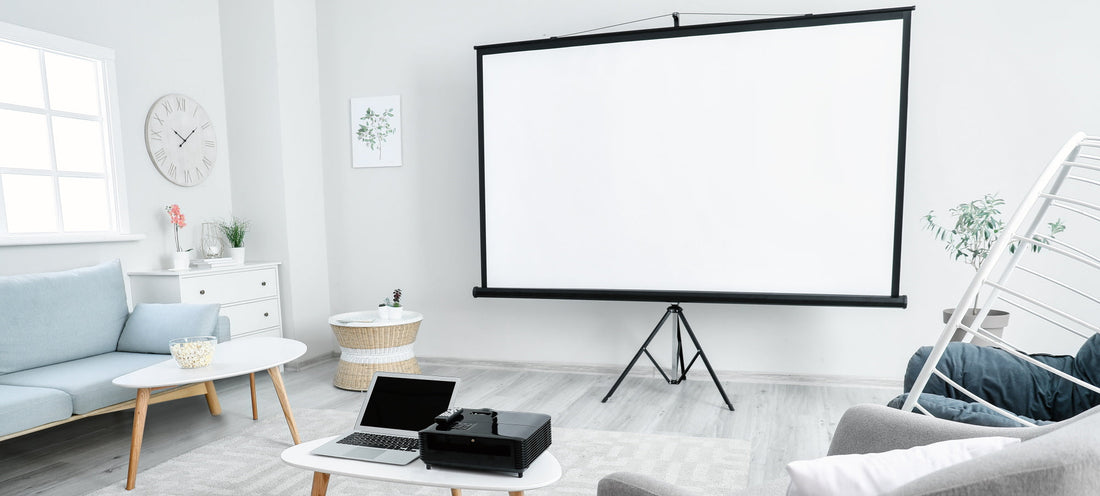
HOME CINEMA SETUP: THE PERFECT PICTURE
Share

Having your own home theater is a real dream for many movie and series enthusiasts. To truly enjoy a thrilling home theater experience, the right image technology is crucial.
In this article, you will learn how to achieve the perfect picture in your home theater — whether with a projector, screen, or TV, with optimal placement and the best connection methods. Practical tips and explanations make it easy even for beginners to implement.
Projector or TV: Making the Right Choice
The first major decision when setting up a home theater concerns the image source. Basically, you have two options:
- Projector: For a true cinema feeling with a large image. Best in darkened rooms.
- TV: Easier to handle, clearly visible even in daylight, brilliant image quality.
Projectors deliver impressive images on surfaces over two meters in diagonal. If there is enough space in the home theater room, a screen also offers more flexibility in choosing the right image position and height — without having to mount a heavy TV on the wall.
TVs, on the other hand, score points with easy installation, richer colors, and better brightness. They also come with built-in speakers, although these should not be relied upon for a true home theater experience.
Projectors for Home Theaters: Choosing the Right Screen
Many home theater beginners wonder whether a plain white wall is sufficient as a projection surface for a projector. While it is basically possible to project an image directly onto a smooth, white wall, the results are usually significantly poorer than with a specialized screen. Walls are rarely truly flat and do not reflect light optimally. This affects contrast, blacks appear grayish, and fine details get lost. Color accuracy can also suffer.
A proper projector screen offers a specially coated surface that reflects light purposefully, increases contrast, and significantly improves image quality.
So if you want to fully exploit the potential of your home theater, you should definitely invest in a high-quality screen. There are different types:
- Fixed frame screen: Permanent installation for the best image.
- Motorized screen: Electrically retractable and extendable.
- Tripod screen: Mobile but less stable.
When choosing, pay attention to the gain factors and select a screen that matches your room and projector.
TVs for Home Theaters
For TVs, at least a 4K model (Ultra HD) is recommended nowadays. Even better: OLED or Mini-LED technologies offer excellent black levels and contrast. Also pay attention to:
- HDR support (High Dynamic Range): For brighter colors.
- Low latency: Especially important for gamers.
- HDMI 2.1 support: For 4K at 120 Hz.
The screen size should match the seating distance; a general rule of thumb is: Diagonal = about 1/2 of the seating distance. For a real cinema feeling, it is recommended to mount the TV on the wall. And even if it seems convenient: do not just place the TV on the floor, as it would be way too low for a comfortable cinema experience.
Connecting the Display Technology
Use high-quality HDMI cables for all connections. Make sure to:
- Use HDMI 2.1 standard for current resolutions and features
- Keep cable lengths as short as possible for optimal signal quality; for longer distances, there are also optical HDMI cables
- Maintain neat cable management for an organized setup
Connect the projector or TV directly to the AV receiver or streaming box to avoid unnecessary signal losses.
Placement and Alignment
The height of the TV or screen should be chosen so that the center of the image is roughly at the eye level of seated viewers. Ideally:
- Eye level around the lower third of the screen
- No extreme tilt angles
- Avoid light sources behind or next to the screen
Questions and Answers
Which is better: projector or TV?
- Projectors are ideal for a true cinema feeling with a large image in dark rooms.
- TVs offer brighter images and are better suited for bright living rooms.
Do I need a screen for the projector?
Yes, a specialized screen greatly improves image quality, contrast, and light output. In very dark rooms and with very bright, smooth walls, it is possible to do without, but it is harder to achieve a true cinema feeling.
How high should the TV or screen be mounted?
The center of the image should be roughly at eye level so that you can watch comfortably.
How should I best connect the display?
Use high-quality HDMI cables, connect directly to the AV receiver or source, and avoid unnecessary adapters or splitters.
Conclusion
For the perfect picture in your home theater, the right choice between projector and TV, a high-quality screen, and clean installation are essential. High-quality connection cables and optimal height positioning will perfect your home theater experience.
